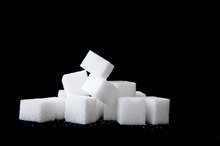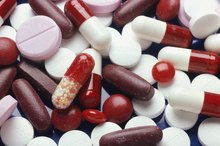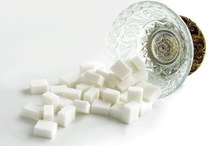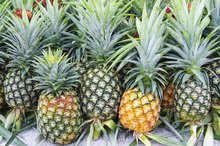What Kind of Sugar Is in Sugar Cane?
Sugar cane is the primary agricultural source of sugar worldwide. The stalk of the sugar cane plant contains a high concentration of sucrose, which is refined into various sugar products. Global sugar production was estimated at nearly 350 billion pounds in 2008-2009, according to the Egyptian Center for Studies of Export & Import.
Harvesting Sugar From Sugar Cane
The sugar cane plant, Saccharum officinarum, is a variety of tall grass that grows in tropical environments throughout the world. The leaves of the plant absorb energy from the sun and produce sucrose from carbon dioxide and water. The stalk of the plant is harvested and processed to isolate and purify the sugar. Sugar cane processing yields several sucrose products, including white and brown granulated sugar, liquid sucrose, liquid invert sugar and molasses. The primary differences in these products are the level of impurities and whether the sucrose is in liquid or crystalline form.
- The sugar cane plant, Saccharum officinarum, is a variety of tall grass that grows in tropical environments throughout the world.
- Sugar cane processing yields several sucrose products, including white and brown granulated sugar, liquid sucrose, liquid invert sugar and molasses.
Sucrose in Food
What is the Complete Oxidation of a Glucose Molecule?
Learn More
Even if you don't have a sweet tooth, sucrose is probably a significant component of your diet. Dairy products, cereals, baked goods and many other processed foods contain added sugar, much of it as sucrose. On average, Americans consume a half-cup of sugar daily, according to the national nutritional survey NHANES 2007-2008. This equates to approximately 385 calories from sugar in your diet each day 1.
- Even if you don't have a sweet tooth, sucrose is probably a significant component of your diet.
- On average, Americans consume a half-cup of sugar daily, according to the national nutritional survey NHANES 2007-2008.
Sucrose Digestion
Sucrose is a disaccharide, meaning it consists of two sugar molecules bound together. Glucose and fructose are the simple sugars that make up sucrose 2. The breakdown of sucrose into its constituent sugars begins in your stomach, through the action of stomach acid. Most of the digestion of sucrose, however, occurs in your small intestine. The cells there produce the enzyme sucrase, which breaks the chemical bond between glucose and fructose. Once this bond is broken, free fructose and glucose molecules are absorbed into your bloodstream.
- Sucrose is a disaccharide, meaning it consists of two sugar molecules bound together.
- The cells there produce the enzyme sucrase, which breaks the chemical bond between glucose and fructose.
Sucrose Metabolism
Common Uses of Sucrose
Learn More
Your body metabolizes the glucose and fructose from sugar cane-derived sucrose differently. Your cells use glucose as the primary fuel for energy production. Two different cellular processes produce energy from glucose. Aerobic glucose metabolism requires oxygen and is the most efficient mechanism your body has to produce energy. Anaerobic glucose metabolism occurs without oxygen but produces less energy than aerobic metabolism. Glucose not immediately needed for energy production is stored in your liver and muscles or converted into fat. Your body cannot use fructose directly. Your liver must first convert it into the metabolic intermediate fructose-1-phosphate, which enters into the chemical process for energy production, if needed. If your body's energy needs are met, fructose-1-phosphate is routed for fat production.
- Your body metabolizes the glucose and fructose from sugar cane-derived sucrose differently.
- Aerobic glucose metabolism requires oxygen and is the most efficient mechanism your body has to produce energy.
Related Articles
References
- Ask the Dietitian: Could You Please Tell Me How Many Calories Are in One Teaspoon of Sugar?; Joanne Larsen
- Elmhurst College Virtual Chembook; Sucrose; Charles E. Ophardt, Ph.D.; 2003
- "Nutrition Almanac"; John D. Kirschmann and Nutrition Search Inc.; 2007
- Popkin BM, Hawkes C. Sweetening of the global diet, particularly beverages: patterns, trends, and policy responses. Lancet Diabetes Endocrinol. 2015;4(2):174-186. doi:10.1016/S2213-8587(15)00419-2
- New Hampshire Department of Health and Human Services. How much sugar do you eat?. Updated August 2014.
- DeSilver D. How America's diet has changed over time. Pew Research Center. Updated December 13, 2016.
- Lakhan SE, Kirchgessner A. The emerging role of dietary fructose in obesity and cognitive decline. Nutr J. 2013;12:114. doi:10.1186/1475-2891-12-114
- Djiogue S, Nwabo Kamdje AH, Vecchio L, et al. Insulin resistance and cancer: the role of insulin and IGFs. Endocr Relat Cancer. 2013;20(1):R1-R17. doi:10.1530/ERC-12-0324
- Page KA, Chan O, Arora J, et al. Effects of fructose vs glucose on regional cerebral blood flow in brain regions involved with appetite and reward pathways. JAMA. 2013;309(1):63-70. doi:10.1001/jama.2012.116975
- Goran MI, Ulijaszek SJ, Ventura EE. High fructose corn syrup and diabetes prevalence: a global perspective. Glob Public Health. 2013;8(1):55-64. doi:10.1080/17441692.2012.736257
- Walker RW, Dumke KA, Goran MI. Fructose content in popular beverages made with and without high-fructose corn syrup. Nutrition. 2014;30(7-8):928-35. doi:10.1016/j.nut.2014.04.003
- American Heart Association. Added sugars. Updated April 17, 2018.
Writer Bio
Dr. St. John is a medical writer and editor with more than 15 years experience in the field. She is a former medical officer for the Centers for Disease Control and Prevention.









